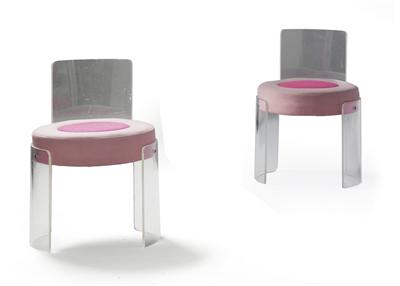A pair of chairs,

designed by Cesare Maria Casati & C. Emanuele Ponzio, for the discotheque Il Grifoncino in Bolzano, Italy, in 1968/69, bent and bolted plexiglass, foam, felt in two pink tones, height 66 cm, diameter 45 cm, height of seat 42 cm. (DR)
Provenance: - Discotheque Il Grifoncino, Hotel Grifone, Bolzano, Italy – Coll. Engelhorn, Vienna.
Lit.: “Il night piu piccolo”, in: Domus, no. 491, October 1970, pp. 29–31 - F. Ferrari, Discoteca 1968, L’Architettura Straordinaria, Umberto Allemandi, 1989.
Il Grifoncino used to be one of the most hip nightclubs in Italy. On a floor space of 70 m2, the spirit of a new generation manifested itself: instead of the familiar dark, cave-like club rooms, this room presented itself in transparent plexiglass, PVC foils, chromium coated plastic, and dynamic light effects. In the tunnel shaped room, barrel shaped transparent plexiglass seats and tables were grouped around a stainless steel dance floor. Above the dance floor appeared what could be called a “wasps’ nest“ of chromium plated plastic. Transparent PVC curtains in the shape of clouds suspended from the ceiling were used to separate the dance floor from the seating area; they had an acoustic function rather than serving as a screen. Only a few coloured spots accentuated the transparent and white ambience: a hedge of dark green plexiglass panels was silhouetted along the walls, and the cushions of the seats were glaring pink. Dark blue carpeting was used as flooring around the metal dance floor. Only when the special lighting was activated did the cool atmosphere turn into an extraordinary light spectacle: the tables and bar stools were lit from below with black light transforming the plexiglass furniture into violet and blue shapes. “Globo tissurato” by Ugo L Pietra or “Cespuglio di Gino” by Ennio Lucini, both dating from the same year, i.e., 1968, worked in a very similar manner. The transparent and reflecting materials guaranteed a wide spectrum of optical effects. In addition, the lighting was linked to the hi-fi equipment so that the entire room was filled by the vibrations of the light and music. In conceiving Il Grifoncino, the two architects Cesare Casati and Emanuele Ponzio and Gino Marotta, who designed the walls and the cloud curtains, had created an ambience that perfectly reflected the lifestyle of the late 1960s.
“This is how we should live, in immense spaces, with the sky and the air and room doing everything that comes to our mind. To have enough room to live as a tribe, with people coming and going and greeting one another, with kisses, hugs, laughter, and gossip – rooms for cartwheels and everlasting music and dancing.” (Ettore Sottsass in 1969)
Expert: Günther Minichreiter
 Günther Minichreiter
Günther Minichreiter
+43-1-515 60-528
guenther.minichreiter@dorotheum.at
27.11.2012 - 17:00
- Odhadní cena:
-
EUR 5.000,- do EUR 6.000,-
A pair of chairs,
designed by Cesare Maria Casati & C. Emanuele Ponzio, for the discotheque Il Grifoncino in Bolzano, Italy, in 1968/69, bent and bolted plexiglass, foam, felt in two pink tones, height 66 cm, diameter 45 cm, height of seat 42 cm. (DR)
Provenance: - Discotheque Il Grifoncino, Hotel Grifone, Bolzano, Italy – Coll. Engelhorn, Vienna.
Lit.: “Il night piu piccolo”, in: Domus, no. 491, October 1970, pp. 29–31 - F. Ferrari, Discoteca 1968, L’Architettura Straordinaria, Umberto Allemandi, 1989.
Il Grifoncino used to be one of the most hip nightclubs in Italy. On a floor space of 70 m2, the spirit of a new generation manifested itself: instead of the familiar dark, cave-like club rooms, this room presented itself in transparent plexiglass, PVC foils, chromium coated plastic, and dynamic light effects. In the tunnel shaped room, barrel shaped transparent plexiglass seats and tables were grouped around a stainless steel dance floor. Above the dance floor appeared what could be called a “wasps’ nest“ of chromium plated plastic. Transparent PVC curtains in the shape of clouds suspended from the ceiling were used to separate the dance floor from the seating area; they had an acoustic function rather than serving as a screen. Only a few coloured spots accentuated the transparent and white ambience: a hedge of dark green plexiglass panels was silhouetted along the walls, and the cushions of the seats were glaring pink. Dark blue carpeting was used as flooring around the metal dance floor. Only when the special lighting was activated did the cool atmosphere turn into an extraordinary light spectacle: the tables and bar stools were lit from below with black light transforming the plexiglass furniture into violet and blue shapes. “Globo tissurato” by Ugo L Pietra or “Cespuglio di Gino” by Ennio Lucini, both dating from the same year, i.e., 1968, worked in a very similar manner. The transparent and reflecting materials guaranteed a wide spectrum of optical effects. In addition, the lighting was linked to the hi-fi equipment so that the entire room was filled by the vibrations of the light and music. In conceiving Il Grifoncino, the two architects Cesare Casati and Emanuele Ponzio and Gino Marotta, who designed the walls and the cloud curtains, had created an ambience that perfectly reflected the lifestyle of the late 1960s.
“This is how we should live, in immense spaces, with the sky and the air and room doing everything that comes to our mind. To have enough room to live as a tribe, with people coming and going and greeting one another, with kisses, hugs, laughter, and gossip – rooms for cartwheels and everlasting music and dancing.” (Ettore Sottsass in 1969)
Expert: Günther Minichreiter
 Günther Minichreiter
Günther Minichreiter
+43-1-515 60-528
guenther.minichreiter@dorotheum.at
|
Horká linka kupujících
Po-Pá: 10.00 - 17.00
kundendienst@dorotheum.at +43 1 515 60 200 |
| Aukce: | Design |
| Typ aukce: | Salónní aukce |
| Datum: | 27.11.2012 - 17:00 |
| Místo konání aukce: | Wien | Palais Dorotheum |
| Prohlídka: | 17.11. - 27.11.2012 |
